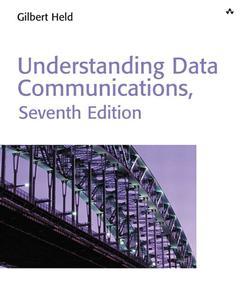Understanding data communications (7th Ed.)
Auteur : HELD Gilbert

Understand the ins and outs of data communications.
- Understanding Data Communications, Seventh Edition presents complex data communications concepts clearly and concisely within a tutorial format.
- All of the concepts are modern and up-to-date, in sync with the current and future data communication market ranging from wireless communications to communication security.
- The award-winning author is internationally recognized for his expertise in the field of communication.
Gilbert Held in an internationally recognized author and lecturer who specializes in the applications of computer and communications technology. He is a frequent lecturer and conducts seminars on topics such as LAN/WAN internetworking, data compression, and PC hardware and software. Held is the author of more than 40 books on computers and communications technology, including the top selling Data Over Wireless Networks (McGraw-Hill Professional Publishing). He has won several awards for his technical excellence in writing.
This Books Approach to Data Communications.
1. An Overview of Data Communications.
The First Data Communications Systems.
The Telegraph.
Two-State Communications Systems.
Bytes and Octets.
Early Communications Codes.
Baudot Code.
Modern Codes.
EBCDIC.
ASCII.
The Escape Character.
Teleprinters.
Data Communications in Computing.
The 1960s.
The 1970s.
The 1980s.
The 1990s.
Into the New Millennium.
Changes in the Industries.
Communications Industry Revolution.
Emerging Technologies.
General Description of Data Communications Systems.
The DTE-DCE Interface.
The Effect of Telecommunications Reform.
What You Have Learned.
Quiz for Chapter 1.
2. Terminal Devices.
Terminals.
Teleprinters Versus CRT Terminals.
Serial Printers.
Nonimpact Printers.
CRT Terminals.
Non-ASCII Terminals.
Specialized Terminals.
Parts of a Terminal.
Keyboards.
Display Considerations.
PC Terminals.
The Need for Speed.
The Ubiquitous Terminal.
Data Transmission.
Asynchronous Transmission.
Other Types of Transmission.
What You Have Learned.
Quiz for Chapter 2.
3. Messages and Transmission Channels.
Using Redundancy in Communications.
Using Redundancy for Data Compression.
Bounded Medium.
Coaxial Cable.
Waveguide.
Fiber-Optic Systems.
Building Cabling Standards.
Unbounded Medium.
Microwave Radio.
Satellite Radiolink Systems.
Commercial Satellites.
LEOS Satellites.
Cellular Radio Systems.
Effects of Bandwidth on a Transmission Channel.
Intersymbol Interference.
Bandwidth Requirements for Signals.
Digital Signals.
Carrier Systems.
Using Time.
Using Pulse Code Modulation.
What You Have Learned.
Quiz for Chapter 3.
4. Asynchronous Modems and Interfaces.
Solving the Problem with Modems.
Modem Interfaces.
Analog Modulation.
Low-Speed Modem Frequency Modulation Methods.
Frequency-Shift Keying.
V.21 Standard.
V.22bis.
Modem Features.
Bit Errors on Compressed Data.
Error Detection and Correction.
The MNP Protocol.
V.42 Recommendation.
Interface and Signaling Standards.
The Mechanical Interface.
Electrical and Functional Signals.
Subset of Signals.
Examples of RS-232 Connections.
Asynchronous Modem Control.
Nonstandard Use of the RS-232 Standard.
Limitations of RS-232.
Other Interfaces.
Date de parution : 03-2002
Ouvrage de 760 p.
19x23 cm
Thème d’Understanding data communications :
Ces ouvrages sont susceptibles de vous intéresser

Wireless Optical Communications 172,68 €


